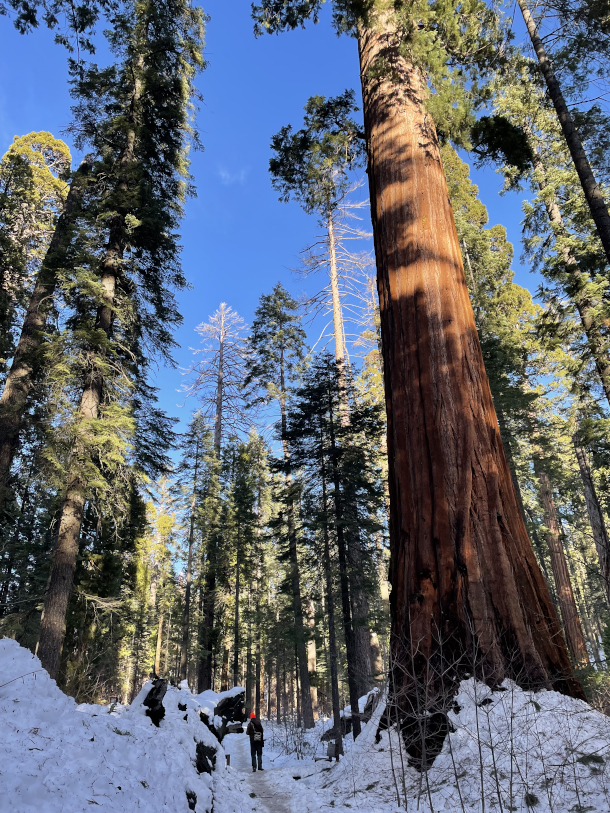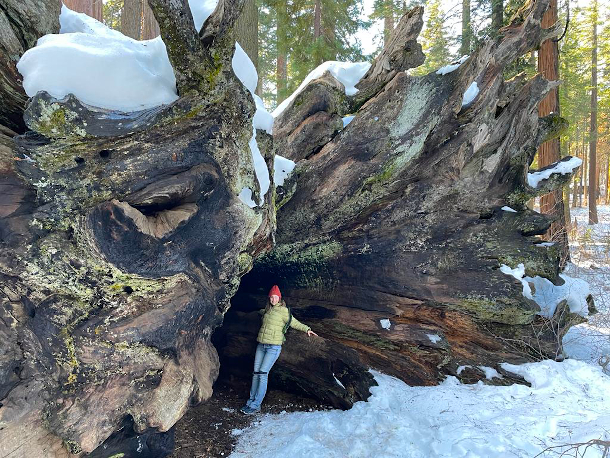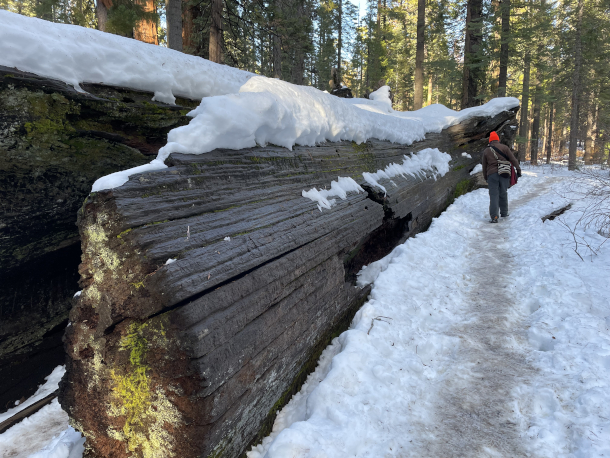Legends of the Forest
Air Date: Week of April 21, 2023

Jennifer Junghans’ best friend Matthias Rös among the giant sequoias at Calaveras Big Trees State Park in California. (Photo: Jennifer Junghans)
Writer Jennifer Junghans joins Living on Earth’s Aynsley O’Neill to share her essay, “Legends of the Forest” about a visit to a grove of giant sequoia trees and the stories they hold in their ancient, towering trunks.
Transcript
BASCOMB: Living on Earth’s Aynsley O’Neill is here now with writer Jennifer Junghans as we continue our celebration of Earth Day.
O’NEILL: Jennifer Junghans has produced commentaries for us that range from stories about the most distant stars to the challenges of a mother coyote living in the city.
In honor of Earth Day, she wrote an essay, called Legends of the Forest.
Big Trees: Legends of the Forest
We sink in the snow as we set out among the mythic giant sequoias. It feels as though we have come to a land of legends. As though we are time travelers, wandering into an ancient world, standing before living monoliths 2,000 years old. We touch their trunks — some as wide as a theater’s stage — and we strain to look upward, following their reach into the sky hundreds of feet, piercing a realm outside of Earth’s. They are stately and reverent, but my mind runs wild with the secrets they know and the stories they could tell.

Jennifer Junghans at the base of an old fallen giant sequoia. (Photo: Matthias Rös)
Stories of survival and death, love and loss, victory and defeat of the people, the animals and the forest itself. All of life has happened across millennia in this very place. The generations of Miwok and Washoe people who lived in this forest and came to know these giants. And Augustus T. Dowd, who stumbled upon this grove in 1852 as he stalked a wounded grizzly bear. His discovery drew flocks eager to carve up this priceless old growth for profit. And the wounded bear who fled from Augustus to the forest for cover. Did he brush against the trees we touch? Clamber up them? Did he see what we see? Do we stand upon his final resting place?
The sequoia know. And they have their own stories. Their bodies scarified with the passage of time told in gnarls and hollows, trunks grown askew and walls of charcoal from lightning bolts that spare no one.
As we stop to rest, my friend Matthias pulls out chocolate and we savor it like a sacrament here in the forest. In the quiet I can’t help but think of the abundance of life that calls this place home. Foxes, flying squirrels, porcupines, owls, pileated woodpeckers, bobcats and bears. I wonder if in their mastery of their environment they are watching us as I daydream of watching them.

Matthias Rös walking through the snow alongside an old sequoia trunk. (Photo: Jennifer Junghans)
We weave along the forest floor. We’re looking for the mammoth of a hollow fallen tree. We hope to walk through it, but the storm has flooded it and it looks like a half sunken ship from medieval times. Instead we go to opposite sides to wave at each other from afar like kids do through tunnels.
The lengthening shadows tell us it is time to leave but I’ll always return to this true north where life endures. Something that will outlive us and generations to come, but only if we tread lightly and choose to fiercely protect this fragile ecosystem. Where the sequoias are the oldest living recorders of the region’s history, folding our complicated, messy and beautiful stories into their own. Where we can come to see and feel and touch vaults of time in these statues that live in the forest.

Jennifer Junghans near the enormous stump of a felled giant sequoia. (Photo: Matthias Rös)
O’NEILL: Well, we've been thinking a lot about the concept of celebrating the earth for this Earth Day special. To you, what does it mean to celebrate the earth? And how is that reflected in this story?
JUNGHANS: Well, we do have such an amazing planet that is worth celebrating every day. And for me, visiting these trees, there's an innate value to them simply because they are, there's this intrinsic value because they are simply so beautiful and overwhelming in their, in their beauty and their presence. And at the same time, you know, we have to think about the value of these trees as a natural resource. And everything that they provide to all life on Earth, I mean, they clean our water and they absorb our greenhouse gases and they produce oxygen that we breathe and they provide the shelter and food and habitat for countless flora and fauna and, and this is simply by, by being alive -- this is simply what they do.
O’NEILL: Writer Jennifer Junghans
Links
Living on Earth wants to hear from you!
Living on Earth
62 Calef Highway, Suite 212
Lee, NH 03861
Telephone: 617-287-4121
E-mail: comments@loe.org
Newsletter [Click here]
Donate to Living on Earth!
Living on Earth is an independent media program and relies entirely on contributions from listeners and institutions supporting public service. Please donate now to preserve an independent environmental voice.
NewsletterLiving on Earth offers a weekly delivery of the show's rundown to your mailbox. Sign up for our newsletter today!
 Sailors For The Sea: Be the change you want to sea.
Sailors For The Sea: Be the change you want to sea.
 The Grantham Foundation for the Protection of the Environment: Committed to protecting and improving the health of the global environment.
The Grantham Foundation for the Protection of the Environment: Committed to protecting and improving the health of the global environment.
 Contribute to Living on Earth and receive, as our gift to you, an archival print of one of Mark Seth Lender's extraordinary wildlife photographs. Follow the link to see Mark's current collection of photographs.
Contribute to Living on Earth and receive, as our gift to you, an archival print of one of Mark Seth Lender's extraordinary wildlife photographs. Follow the link to see Mark's current collection of photographs.
 Buy a signed copy of Mark Seth Lender's book Smeagull the Seagull & support Living on Earth
Buy a signed copy of Mark Seth Lender's book Smeagull the Seagull & support Living on Earth

